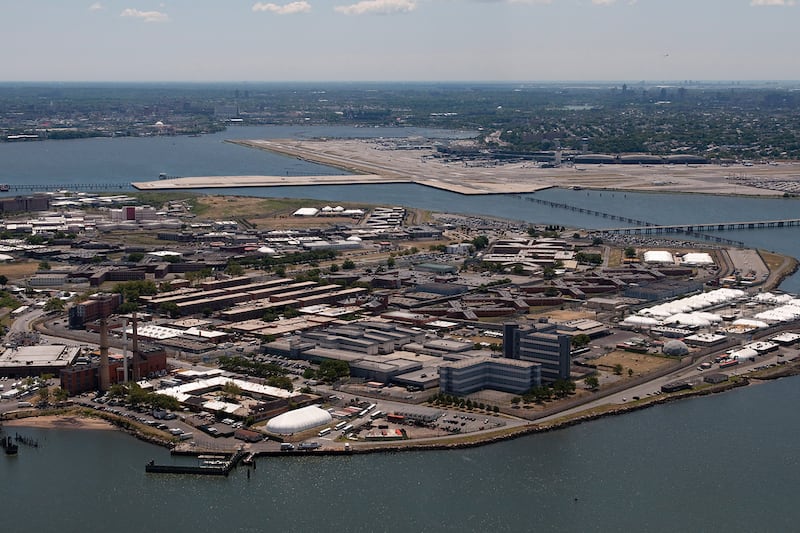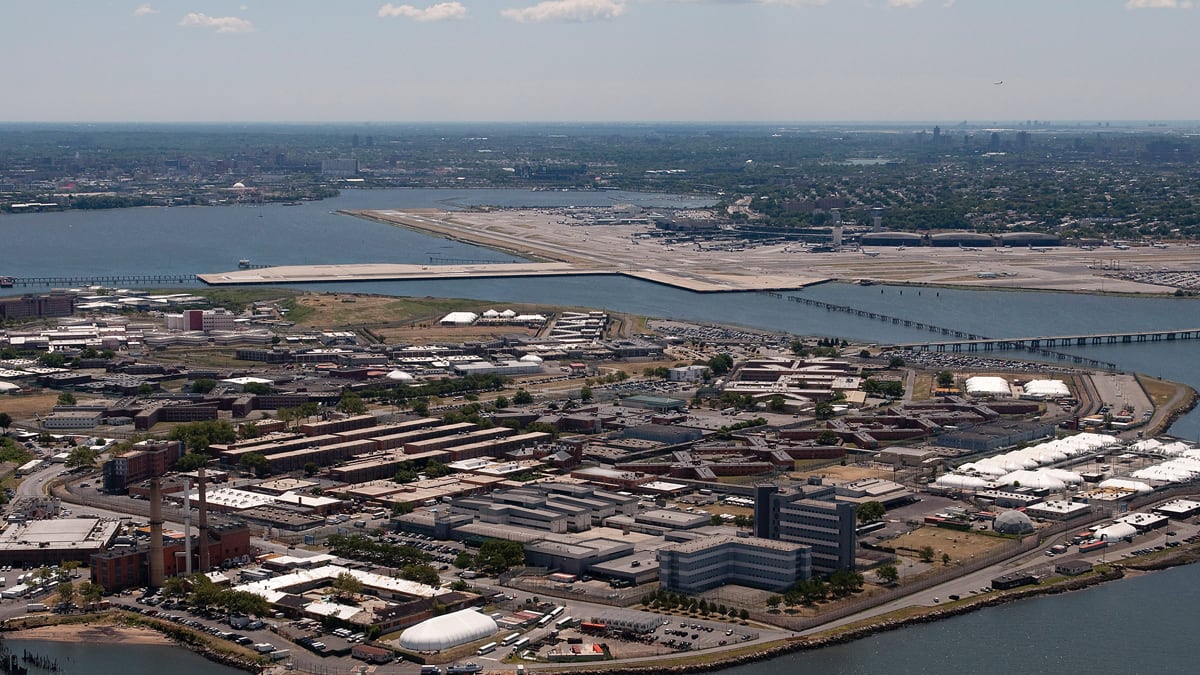In preparation for Hurricane Sandy, New York City was divided into evacuation zones: Zone A meant a mandatory evacuation, on the orders of Mayor Michael Bloomberg. Zones B and C were labeled as having a lesser risk for flooding.

One island, in the East River between the Bronx and Queens, was simply designated as a “No Flood Zone:” Rikers.
The 400-acre island is, of course, home to one of the country’s most infamous jails. It houses an average of 12,000 inmates daily—people who are awaiting trial and cannot afford bail, in transit on the way to a longer-term facility, or sentenced to less than a year in jail. It was Rikers, for example, where then-IMF chief Dominique Strauss-Kahn spent his nights after being denied bail for the alleged rape of a hotel maid. The city employs about 7,000 staff members on the island, in addition to 1,500 civilian employees. It is only accessible via a bridge from Queens, either by bus or private car.
ADVERTISEMENT
New York’s Department of Corrections wrote in a statement prior to Hurricane Sandy that they were prepared to evacuate the island in the “highly unlikely” event that it would be necessary, though no specifics were outlined. The staff remained on the island throughout the storm to “keep the facility self-sustaining,” and NYCDOC commissioner Dora Schriro even spent Monday night at Rikers. Staffers, representative Robin Campbell said, stayed on the island in case of any problems.
The NYCDOC has remained steadfast that even these precautions were not necessary. According to Campbell, at no point was Rikers Island under any threat from the storm: no power outage, no flooding. The facility, Campbell said, is meant to withstand storms up to Category 4, and since Hurricane Sandy was a Category 1 storm, it would be “extremely unlikely” that the facility would need to be evacuated. A small portion of the perimeter of the island is considered in Zone C and would be vulnerable to flooding, but there are no jails in that area.
But there are many who don’t take comfort in the NYCDOC statements, especially given the way the city was brought on its knees after Sandy hit.
“It’s just not right,” said Margaret Shelton, a Queens resident whose daughter was at Rikers during the storm. “It’s like they left these people out.”
Shelton, coming from the facility on Thursday night, said she was “really worried” about her daughter and the rest of the inmates, and she searched for updates.
“When you have a family member here, you watch the news everyday—you need to know what’s going on and they’re not going to tell you,” Shelton said.
Even less comfort to many is Mayor Michael Bloomberg’s response on Sunday when asked about how the storm would fare when Sandy hit. “Rikers Island is up where they are and jails are secure,” Bloomberg said. “Don’t worry about anyone getting out.”
But getting out isn’t exactly the problem. Lisa Ortega, whose 16-year-old son was jailed at Rikers last year during Hurricane Irene, thinks the “fortified island” idea—nobody can get in and nobody can get out—becomes a problem if the island floods.
During Irene, Ortega said the inmates were locked in their cells as the storm hit. “There was a high level of panic going on,” Ortega said. She said her son and the other inmates were given sandwiches and locked in their cells overnight during the storm—which she said they only heard about from family, not from the staff at Rikers.
A former inmate of Rikers herself, Ortega said the first thought she had when arriving on the island was that she had to get out of there. “You think you are left for dead.”
“There are 12,000 people in there—do they have 12,000 life jackets?” Ortega asked. “Rikers on a good day has leaks.”
According to Ortega, her son had Hurricane Katrina on his mind before the storm. It’s not an understandable, if not analagous, concern: In New Orleans just prior to Hurricane Katrina, the sheriff declared that prisoners at the Orleans Parish Prison” would stay despite the mayor’s evacuation order of the city—and the prison reportedly even accepted other prisoners that facilities that did evacuate. But the prison flooded, power went out and deputies left their posts, leaving the prisoners locked in the cells as the seawater rose. According to a 2006 report by the American Civil Liberties Union, prisoners went days without food, water or ventilation before being evacuated on by order of the state. Deputies admitted later they had no emergency training and said they were unaware of any evacuation plan; some guards were locked into their posts, unable to provide any assistance. The prisoners were then sent to other facilities, with thousands of men being sent to the Elayn Hunt Correctional Center, where many were reportedly sent outside.
The Orleans Parish Prison is not an isolated example: a jail in Iowa was forced to undergo an emergency evacuation in 2008 when water rose at the facility, located at the confluence of the Des Moines and Raccoon Rivers. During Hurricane Sandy, New Jersey Gov. Chris Christie ordered the evacuation of the low-lying Southern State Correction Facility in Cumberland County, housing the inmates in temporary prisons.
The possibility of flooding at Rikers is not completely alien. During the worst of Sandy, water covered the runway at LaGuardia Airport, located directly across the East River from the jail. Adding to concern over Rikers is that 75 percent of the island is a landfill, which is generally considered to be more susceptible to flooding.
Jean Casella, co-director of Solitary Watch, a blog dedicated to news about life in solitary conferment, said she is not questioning the Department of Corrections when it says it does not need to evacuate Rikers—but the possibility remains that at some point there will be a natural or man-made disaster that could threaten the facility.
While Casella said it appears NYCDOC seems better prepared this year than it did for Hurricane Irene, she said “what wasn’t reassuring is that it’s hard to imagine what an evacuation plan from an island with 12,000 people on it would look like.”
Manhattan resident Gordiva Canela, whose boyfriend was at Rikers during Hurricane Sandy, said just looking at the island made her think it could “easily flood—you’re right in the middle of water.” And don’t forget, Canela said, the prisoners are locked in.
“Even though they’re in jail, they’re still people,” Canela said.





